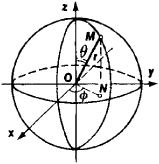spherical coordinates
[′sfir·ə·kəl kō′ȯrd·ən·əts]Spherical Coordinates
The spherical coordinates of a point M are the three numbers r, θ, and ɸ. These numbers are defined relative to three mutually perpendicular axes, which are called the x-axis, y-axis, and z-axis and intersect at the point O (Figure 1). The number r is the distance from O to M. The number θ is the angle between the vector ![]() and the positive direction of the r-axis. The number ɸ is the angle through which the positive half of the x-axis must be turned counterclockwise so that it coincides with the vector
and the positive direction of the r-axis. The number ɸ is the angle through which the positive half of the x-axis must be turned counterclockwise so that it coincides with the vector ![]() where N is the projection of M on the ry-plane. The spherical coordinates of M thus depend on the choice of O and the three axes. The relations between the spherical and Cartesian coordinates are given by the following equations:
where N is the projection of M on the ry-plane. The spherical coordinates of M thus depend on the choice of O and the three axes. The relations between the spherical and Cartesian coordinates are given by the following equations:
x = r sin θ cos ɸ
y = r sin θ cos ɸ
z = r cos θ

Spherical coordinates are widely used in mathematics and in applications of mathematics to physics and engineering.